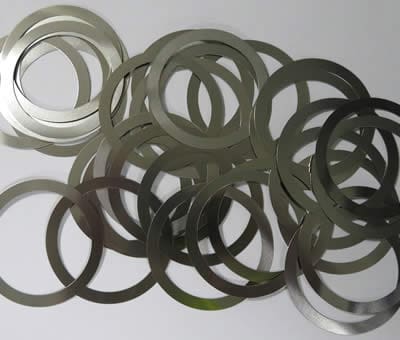Thin Washers


Thin Washers for Spacing, Tolerance, and Alignment
Call 0121 544 5808 Today
Bespoke Manufacturing
Instant Quote Service
Worldwide Delivery
Various Gauges/Thicknesses
Bespoke Manufacturing
Instant Quote Service
Worldwide Delivery
Various Gauges/Thicknesses
What Are Thin Washers?
Thin washers are flat, circular discs with a central hole, characterised by their reduced thickness. They are often used interchangeably with shims or spacers depending on the application.
Key Uses:
- Tolerance control between mating components.
- Precise spacing for movement or airflow.
- Light-duty load distribution on soft materials.
- Component alignment in assemblies.
- Electrical or thermal isolation with non-metallic variants.
Benefits of Thin Washers
1. Precision Tolerance Control
Ideal for micro-adjustments in high-performance assemblies.
2. Efficient Alignment
Corrects misalignment quickly without altering expensive components.
3. Time & Cost Savings
Eliminates the need for re-machining, enabling fast, affordable adjustments.
4. Vibration & Shock Dampening
Nylon, rubber, or neoprene variants reduce vibration and noise.
5. Load Spreading
Prevents damage on soft materials by diffusing the pressure of fasteners.
6. Thermal & Electrical Insulation
Non-metallic washers act as barriers against electrical contact and heat conduction.
7. Quick Maintenance
Easily removable or replaceable without dismantling entire assemblies.
8. Space-Efficient
Extremely thin profile allows for minimal disruption to component spacing.
Applications of Thin Washers
Materials for Thin Washers by Industry
| Material | Properties | Typical Use Cases |
|---|---|---|
| Steel (carbon/spring) | Strong, durable, economical | Automotive, general engineering |
| Stainless Steel (304/316) | Corrosion-resistant, heat-tolerant | Marine, medical, food processing |
| Brass | Conductive, corrosion-resistant | Electrical, electronics, decorative parts |
| Copper | High thermal/electrical conductivity | Circuitry, heat management systems |
| Aluminium | Lightweight, corrosion-resistant | Aerospace, lightweight assemblies |
| Nylon / PTFE | Insulating, chemically resistant | Electronics, low-load environments |
| Rubber / Neoprene / Silicone | Flexible, seals and absorbs vibration | Sealing, HVAC, electronics |
| Titanium | Strong, light, corrosion-proof | Aerospace, military-grade components |
Common Challenges with Thin Washers
1. Susceptible to Bending
- Problem: Easily deform under uneven loads or overtightening.
- Impact: Misalignment or damage to joint integrity.
- Solution: Use hardened or precision-ground washers for load-bearing applications.
2. Difficult Handling
- Problem: Small size makes manual placement tricky.
- Impact: Slower assembly or increased risk of misalignment.
- Solution: Use automated feeders or tabbed washers where applicable.
3. Limited Load Capacity
- Problem: Too thin to carry heavy loads.
- Impact: Can cause fastener loosening.
- Solution: Use reinforced materials or alternate load-spreading solutions.
4. Material Creep (Plastic Types)
- Problem: Plastics may deform over time under heat or pressure.
- Impact: Loss of tolerance or clamping force.
- Solution: Choose temperature-resistant materials like PTFE or PEEK.
5. Vibration Sensitivity
- Problem: Washers shift under high-vibration environments.
- Impact: Loosening or wear over time.
- Solution: Use vibration-damping variants like rubber or neoprene.
6. Corrosion Issues
- Problem: Low-grade metal washers rust in moist environments.
- Impact: Reduced washer integrity or staining.
- Solution: Use stainless, brass, or coated materials for outdoor/chemical settings.
7. Dimensional Inconsistency
- Problem: Poor tolerance control across large batches.
- Impact: Inconsistent fit or performance.
- Solution: Work with ISO 9001-certified washer suppliers.
